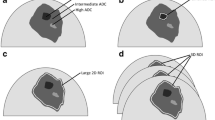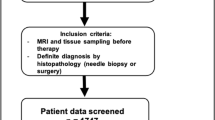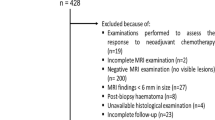Abstract
Objectives
To evaluate the influence of post-processing systems, intra- and inter-reader agreement on the variability of apparent diffusion coefficient (ADC) measurements in breast lesions.
Methods
Forty-one patients with 41 biopsy-proven breast lesions gave their informed consent and were included in this prospective IRB-approved study. Magnetic resonance imaging (MRI) examinations were performed at 1.5 T using an EPI-DWI sequence, with b-values of 0 and 1000 s/mm2. Two radiologists (R1, R2) reviewed the images in separate sessions and measured the ADC for lesion, using MRI-workstation (S-WS), PACS-workstation (P-WS) and a commercial DICOM viewer (O-SW). Agreement was evaluated using the intraclass correlation coefficient (ICC), Bland–Altman plots and coefficient of variation (CV).
Results
Thirty-one malignant, two high-risk and eight benign mass-like lesions were analysed. Intra-reader agreement was almost perfect (ICC-R1 = 0.974; ICC-R2 = 0.990) while inter-reader agreement was substantial (ICC from 0.615 to 0.682). Bland–Altman plots revealed a significant bias in ADC values measured between O-SW and S-WS (P = 0.025), no further systematic differences were identified. CV varied from 6.8 % to 7.9 %.
Conclusion
Post-processing systems may have a significant, although minor, impact on ADC measurements in breast lesions. While intra-reader agreement is high, the main source of ADC variability seems to be caused by inter-reader variation.
Key points
• ADC provides quantitative information on breast lesions independent from the system used.
• ADC measurement using different workstations and software systems is generally reliable.
• Systematic, but minor, differences may occur between different post-processing systems.
• Inter-reader agreement of ADC measurements exceeded intra-reader agreement.



Similar content being viewed by others
References
Baltzer PAT, Benndorf M, Dietzel M et al (2010) Sensitivity and specificity of unenhanced MR mammography (DWI combined with T2-weighted TSE imaging, ueMRM) for the differentiation of mass lesions. Eur Radiol 20:1101–1110
Partridge SC, McDonald ES (2013) Diffusion weighted magnetic resonance imaging of the breast: protocol optimization, interpretation, and clinical applications. Magn Reson Imaging Clin N Am 21:601–624
Dorrius MD, Dijkstra H, Oudkerk M, Sijens PE (2014) Effect of b value and pre-admission of contrast on diagnostic accuracy of 1.5-T breast DWI: a systematic review and meta-analysis. Eur Radiol 24:2835–2847
Wu L-M, Hu J-N, Gu H-Y et al (2012) Can diffusion-weighted MR imaging and contrast-enhanced MR imaging precisely evaluate and predict pathological response to neoadjuvant chemotherapy in patients with breast cancer? Breast Cancer Res Treat 135:17–28
Woodhams R, Ramadan S, Stanwell P et al (2011) Diffusion-weighted imaging of the breast: principles and clinical applications. Radiogr Rev Publ Radiol Soc N Am Inc 31:1059–1084
Sasaki M, Yamada K, Watanabe Y et al (2008) Variability in absolute apparent diffusion coefficient values across different platforms may be substantial: a multivendor, multi-institutional comparison study. Radiology 249:624–630
Landis JR, Koch GG (1977) The measurement of observer agreement for categorical data. Biometrics 33:159–174
Pinker K, Bickel H, Helbich TH et al (2013) Combined contrast-enhanced magnetic resonance and diffusion-weighted imaging reading adapted to the “Breast Imaging Reporting and Data System” for multiparametric 3-T imaging of breast lesions. Eur Radiol 23:1791–1802
Baltzer A, Dietzel M, Kaiser CG, Baltzer PA (2015) Combined reading of contrast enhanced and diffusion weighted magnetic resonance imaging by using a simple sum score. Eur Radiol. doi:10.1007/s00330-015-3886-x
El Kady RM, Choudhary AK, Tappouni R (2011) Accuracy of apparent diffusion coefficient value measurement on PACS workstation: a comparative analysis. AJR Am J Roentgenol 196:W280–284
Donati OF, Chong D, Nanz D et al (2014) Diffusion-weighted MR imaging of upper abdominal organs: field strength and intervendor variability of apparent diffusion coefficients. Radiology 270:454–463
Ye X-H, Gao J-Y, Yang Z-H, Liu Y (2014) Apparent diffusion coefficient reproducibility of the pancreas measured at different MR scanners using diffusion-weighted imaging. J Magn Reson Imaging JMRI 40:1375–1381
Inoue C, Fujii S, Kaneda S et al (2014) Apparent diffusion coefficient (ADC) measurement in endometrial carcinoma: effect of region of interest methods on ADC values. J Magn Reson Imaging JMRI 40:157–161
Lambregts DMJ, Beets GL, Maas M et al (2011) Tumour ADC measurements in rectal cancer: effect of ROI methods on ADC values and interobserver variability. Eur Radiol 21:2567–2574
Bilgili Y, Unal B (2004) Effect of region of interest on interobserver variance in apparent diffusion coefficient measures. AJNR Am J Neuroradiol 25:108–111
Giannotti E, Waugh S, Priba L et al (2015) Assessment and quantification of sources of variability in breast apparent diffusion coefficient (ADC) measurements at diffusion weighted imaging. Eur J Radiol. doi:10.1016/j.ejrad.2015.05.032
Molinari C, Clauser P, Girometti R et al. (2015) MR mammography using diffusion-weighted imaging in evaluating breast cancer: a correlation with proliferation index. Radiol Med. 120(10):911–918
Partridge SC, Mullins CD, Kurland BF et al (2010) Apparent diffusion coefficient values for discriminating benign and malignant breast MRI lesions: effects of lesion type and size. AJR Am J Roentgenol 194:1664–1673
Acknowledgments
The scientific guarantor of this publication is Chiara Zuiani. The authors of this manuscript declare no relationships with any companies whose products or services may be related to the subject matter of the article. The authors state that this work has not received any funding. One of the authors has significant statistical expertise. Institutional review board approval was obtained. Written informed consent was obtained from all subjects (patients) in this study. Methodology: prospective, cross-sectional, performed at one institution.
Author information
Authors and Affiliations
Corresponding author
Rights and permissions
About this article
Cite this article
Clauser, P., Marcon, M., Maieron, M. et al. Is there a systematic bias of apparent diffusion coefficient (ADC) measurements of the breast if measured on different workstations? An inter- and intra-reader agreement study. Eur Radiol 26, 2291–2296 (2016). https://doi.org/10.1007/s00330-015-4051-2
Received:
Revised:
Accepted:
Published:
Issue Date:
DOI: https://doi.org/10.1007/s00330-015-4051-2




